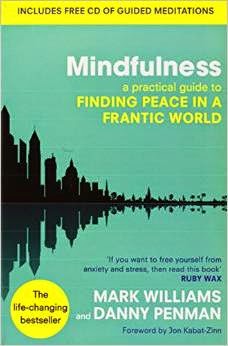Top Ten Tips for Meditation:
 |
| Meditation - not as simple as it sounds..! |
Recently the woes of the world have been playing on my mind.
An unfair society, violent crime, worries over loved ones, and so on. I’m
usually quite ‘happy go lucky’ – but in a world that at times can be so cruel,
it’s not always easy! So recently a good friend of mine recommended I gave
meditation a go. It sounded a good idea and once I looked into it, I wondered
why I’d never really tried it before.
Everyone probably has need for it, yet most of us never seem to
have the opportunity – or rather the patience – to meditate. Personally I’ve always used exercise or
hanging out with friends to escape any deeper concerns or issues I might
be having, but that is still just an escape and lately it hasn’t quite been
doing the trick.
However, my first attempt at meditation was a bit of a
disaster – in fact I had to quit before I went mad! It seemed that the more I
tried to ‘empty my mind’, the more negative nonsense kept popping into it. I
suppose if it was easy we’d all be doing it and the world would be a better
place. Still, I’ve tried to keep going and have actually been having some very
mind-opening experiences of late, especially at night when I end up just
looking at the stars for a while after the meditation – feeling more ‘at one
with the universe’ if not with the planet I’m actually living on!
 |
| Meditation can open your mind while calming it down... |
Anyway, I’ve been researching it a bit and tried to ‘boil
it down’ to the most useful tips I could find. Handy links with more detailed
guidance follow below...
1) Sit still
and tall
You need to be comfortable but not too comfortable because you still need to be aware of your surroundings and not in danger of
dozing off!
2) Relax
Close your eyes and scan through the different parts of your body, from your
toes to the top of your
head, relaxing each one and then moving on to the next. Remember, nobody expects anything from you in this
process, ideally yourself included.
4) Breathe
Breathe naturally until fully inhaled / exhaled: ‘follow your breath’ in your mind.
3) Cleanse your 'chakras'
Breathe
in the ‘clean energy’ from the Earth. Breathe out anxiety and stress. Purify your chakras by doing this with each one (see the link about
chakras below if you’re not too sure about
this part). The position (apparently) of your Chakras:
Tail
bone (root chakra)
Stomach
Diaphragm
Chest
Throat
Middle
eye
Top
of head
Keep
your palms open, supposedly that’s good for energy flow...
5) Remain silent
Be aware but don’t react to or try to change anything. If you hear a sound, don’t ‘name it’ in your mind.
6) Repeat your 'mantra'
Repeat
your mantra with each breath. For example, “I am breathing in / I am breathing
out”, or “Let it go” or
whatever you like, but keep it simple...
7) Keep a calm
mind
Don’t dwell on any thoughts that may pop into your head. You can acknowledge them, but then just
continue focusing on your breathing and your mantra if you’re using one. Keep an ‘empty mind’ – this is the
greatest challenge for me, the more I try to
relax (‘trying’ to relax is probably the problem) the more silly thoughts pop into my head –
even more than usual! But anyway,
don’t give up, a new calmness might end
up taking you by surprise...
8) 'Wake up' slowly...
When you
choose to ‘wake up’, slowly wiggle fingers and toes, and then gradually get up.
9) Find the time
Find the time to do this every day – even if it’s for just 5 minutes. It sounds easy, but
I’ve found it takes more
self-discipline than I expected!
10) Find a place
 |
| Meditating in nature - as ideal as it seems? |
You can
supposedly meditate anywhere – ideally in nature. However, that might not be so realistic for some people.
Even if you do find a place where nobody disturbs you, you might still feel a bit silly if you’re
not in the comfort and safety of your own home. I tried to sit on a hill by the sea the other day, it
was great for a minute or so but then I kept on imagining somebody creeping up behind me!
Then again, I guess I didn’t help myself by watching ‘Constantine’ – a spooky TV series about a Liverpool trickster with supernatural powers – just
before heading off to meditate!
I know it all sounds very nice and healthy but it's actually been quite a challenge of sorts. If it’s difficult for you too, all I can really say
is follow the steps and don’t give up!
What’s the worst that can happen from trying this anyway..?
Of course, if you’re still struggling and there’s something
that’s really bothering you, perhaps
meditation isn’t the way to go? You could try counselling, such as Cognitive Behavioural Therapy, or try taking some action over your perceived
problems if at all possible – you might just find you're worrying too much..!
 |
| Good advice... |
Incidentally, if you need to meditate to help you relax
before falling asleep, this ‘blue energy technique’ seems quite good (though I’m
yet to find a good method to help me get back to sleep in the mornings – if you
know of any, please share it in the comments section below!).
Here are some other useful links on the practice of
meditation, including advice from esteemed thinkers such as Ekhart Tolle and a
guru of Vipassana:
For books on Meditation, here are a few suggestions:
If you have children and they are disturbing your attempts to meditate, why not encourage them to read one of my stories while you practise (there's even a set of 'follow-up' questions for them to answer after each one, so you can read their answers with them when you're both done ;-):
If you're still finding it difficult to escape the 'reality' of everyday human existence, consider this: On Earth, you are presently spinning around at 1700 km per hour, while the Earth is orbiting the Sun at 108,000 km per hour. The Sun in turn is orbiting around the Milky Way galaxy at 790,000 km per hour (on a journey that takes around 200 million years to complete just one orbit), while the Milky Way is rushing through space at around 3,600,000 km per hour. It's all a bit hard to imagine while you're 'sitting still', but it provides a very different perspective does it not?
Anyway, I hope you found these hints and tips useful. A peaceful
mind makes for a more peaceful world – hopefully... Good luck.












































